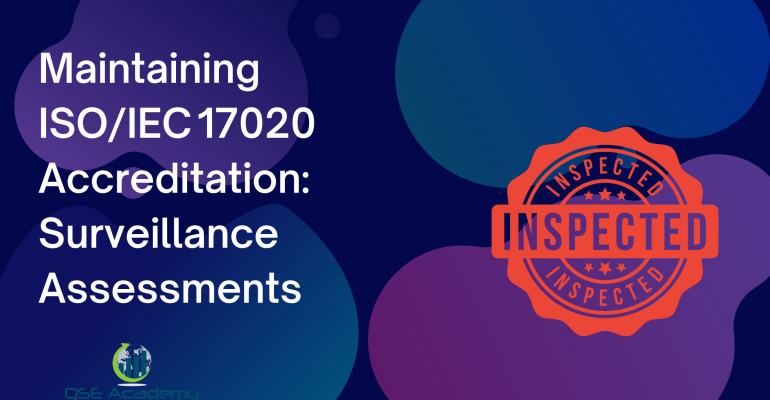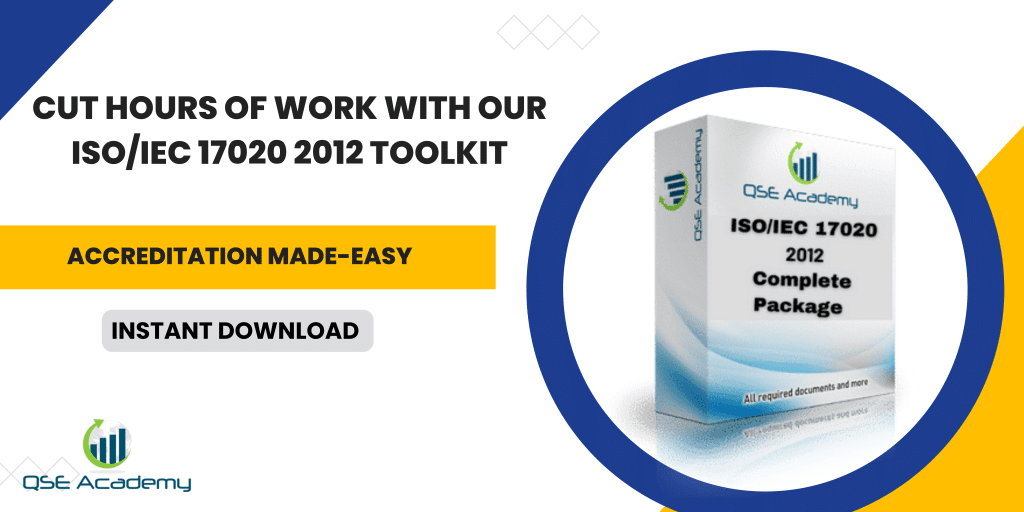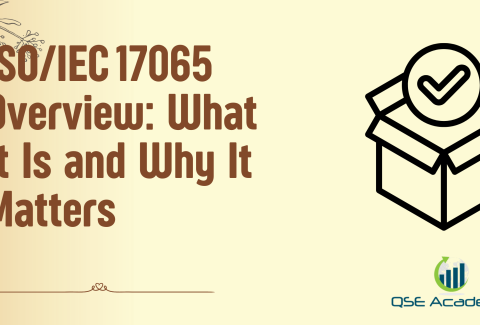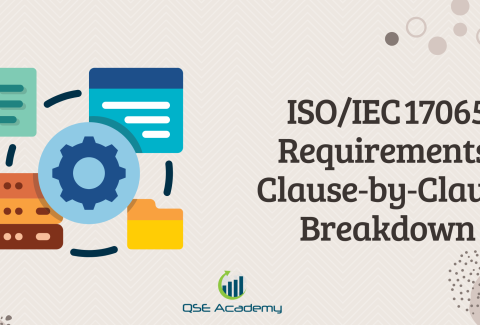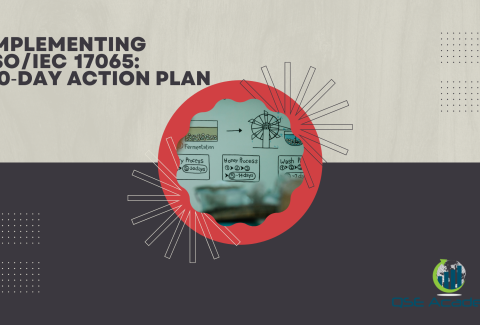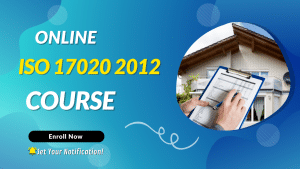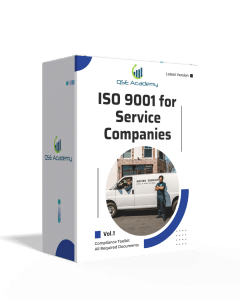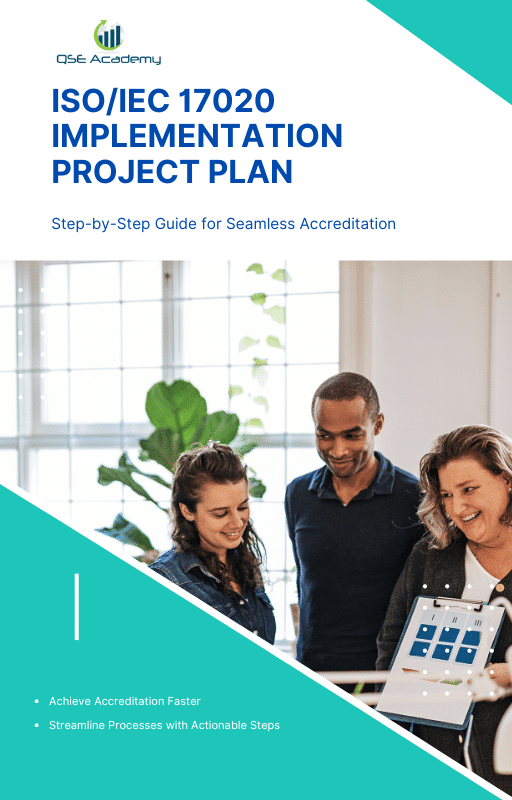Maintaining ISO/IEC 17020 Accreditation: Surveillance Assessments
Last Updated on October 22, 2025 by Hafsa J.
Understanding ISO/IEC 17020 Surveillance Assessments and Continuous Accreditation
Getting accredited to ISO/IEC 17020 is a big achievement—but keeping that accreditation is where most inspection bodies are truly tested.
Many organizations breathe a sigh of relief after receiving their certificate, only to realize a year later that the surveillance assessment is already around the corner. And that’s when panic often starts: “What exactly do they check again? How detailed will it be? What if something changed since last year?”
Here’s the truth—maintaining ISO/IEC 17020 accreditation is not about repeating the same audit every year. It’s about proving that your management system remains alive, consistent, and effective long after the initial accreditation. Surveillance assessments are designed to make sure your processes haven’t drifted, your inspectors are still competent, and your impartiality controls continue to work.
In my experience helping inspection bodies through their first and second surveillance cycles, the best-performing ones treat these audits as a health check, not a threat. They use them to identify blind spots, refresh training programs, and confirm that improvements made after the initial audit are still delivering results.
In this article, you’ll learn:
-
What ISO/IEC 17020 surveillance assessments are and why they matter for long-term accreditation.
-
How often surveillance audits occur and what they typically cover.
-
How to prepare your team, documentation, and systems to maintain compliance year after year.
By the end, you’ll understand how to approach surveillance assessments confidently—turning them into a tool for continuous improvement rather than a source of anxiety.
What Is an ISO/IEC 17020 Surveillance Assessment and Why It Matters
Let’s start with the basics.
An ISO/IEC 17020 surveillance assessment is a periodic audit carried out by your accreditation body (AB)—usually once every 12 months—to make sure your inspection body continues to comply with the requirements of ISO/IEC 17020:2012. It’s not a re-accreditation or a full assessment; rather, it’s a focused review to confirm that your management system is still implemented, functional, and effective.
Think of it as your organization’s annual performance review. The AB wants to ensure that the improvements you made during initial accreditation haven’t faded over time and that your system is being used, not just maintained on paper.
In my experience, this is the point where many inspection bodies trip up. They assume that once accredited, the system will “run itself.” But a living quality management system needs care—updated procedures, trained inspectors, regular audits, and management attention. When these elements start slipping, the surveillance audit becomes a wake-up call.
Here’s how surveillance fits within the bigger picture of accreditation:
Table 1 – Comparing ISO/IEC 17020 Assessment Types
| Audit Type | Purpose | Frequency | Scope of Review | Outcome |
|---|---|---|---|---|
| Initial Assessment | To verify full compliance before granting accreditation | Once (before certification) | Full review of documentation, staff, impartiality, and inspection activities | Accreditation granted |
| Surveillance Assessment | To ensure continued implementation and effectiveness | Every 12 months (typical) | Partial review focused on key areas, updates, and risk points | Accreditation maintained |
| Reassessment (Renewal) | To re-evaluate the entire management system after the full cycle | Every 5 years | Complete review, similar to initial audit | Accreditation renewed for another cycle |
Why it matters:
Surveillance audits protect the credibility of your accreditation. Clients, regulators, and international partners trust your inspection reports because they know your organization is continuously verified.
Failing to maintain your accreditation doesn’t just risk losing the certificate—it can directly impact contracts, client trust, and even your ability to operate legally in regulated industries.
Pro Tip:
Don’t view the surveillance assessment as a box-checking exercise. Use it as a structured opportunity to test your processes, re-evaluate risks, and show measurable improvement since your last audit.
Common Pitfall:
Assuming that “no complaints” means “no findings.” Even without major issues, assessors often focus on improvement opportunities or overlooked records—especially in competence management, impartiality monitoring, and document control.
ISO/IEC 17020 Surveillance Assessment Cycle and Frequency
Once your organization is accredited, your accreditation body (AB) sets a schedule for regular surveillance audits to confirm that your inspection system continues to operate in compliance.
These ISO/IEC 17020 surveillance assessments form part of a continuous 5-year accreditation cycle—usually one audit per year, followed by a reassessment at the end of the cycle.
From experience, I can tell you that the timing and intensity of these audits depend heavily on your risk profile, scope complexity, and past audit performance. If your first year after accreditation goes smoothly, the second surveillance often focuses on improvements and trend analysis. But if you’ve had significant nonconformities, expect deeper follow-up next time.
Table 2 – Typical ISO/IEC 17020 Accreditation and Surveillance Cycle
| Year | Audit Type | Primary Objective | Focus Areas | Conducted By |
|---|---|---|---|---|
| Year 0 | Initial Accreditation | Verify full system compliance with ISO/IEC 17020 | Documentation, competence, impartiality | AB assessment team |
| Year 1 | Surveillance 1 | Confirm effective system implementation | Internal audits, CAPA closure, impartiality | AB assessors |
| Year 2 | Surveillance 2 | Evaluate improvements and stability | Management review, inspector competence | AB assessors |
| Year 3 (optional) | Additional Surveillance (for complex or high-risk scopes) | Monitor ongoing control and consistency | Field inspections, record review | AB assessors |
| Year 5 | Reassessment | Conduct a full re-evaluation to renew accreditation | Entire management system and scope | AB technical team |
How Frequency Is Determined:
-
Accreditation Body Policy: Most ABs require annual surveillance, but some offer flexibility (e.g., every 18 months for low-risk scopes).
-
Scope Complexity: High-risk sectors—like NDT, construction, or pressure vessels—may require more frequent follow-up.
-
Nonconformity History: Repeated issues or slow corrective-action closures can shorten the interval between audits.
-
Organizational Changes: Major structural changes, new inspection sites, or new service categories may trigger an extra surveillance visit.
Pro Tip:
Use the time between surveillance audits to review performance indicators—number of inspections, internal audit results, complaint trends. If you can show data-driven improvements, surveillance becomes far easier and faster.
Common Pitfall:
Failing to maintain readiness all year. Many inspection bodies start preparing only a month before surveillance, creating rushed updates and missing evidence. Continuous readiness is the only reliable strategy.
ISO/IEC 17020 Surveillance Assessment Process Step-by-Step
Now that you know when surveillance audits happen, let’s walk through how they actually unfold.
An ISO/IEC 17020 surveillance assessment isn’t as long or as comprehensive as the initial accreditation audit, but it’s still a formal and systematic evaluation. Its main goal is to verify that your inspection body’s management system continues to function effectively—and that improvements made since the last audit are being maintained.
From the first notification to the final approval letter, the process usually follows six clear stages.
Table 3 – ISO/IEC 17020 Surveillance Assessment Process
| Phase | What Happens | Typical Duration | Deliverable |
|---|---|---|---|
| 1. Pre-Audit Notification | The accreditation body sends you a surveillance notice, updated forms, and requests for key documents. | 2–4 weeks before the audit | Surveillance audit plan |
| 2. Off-Site Document Review | Assessors review changes in your QMS, new procedures, CAPA status, internal audits, and management reviews. | 3–5 days | Review checklist |
| 3. On-Site (or Remote) Assessment | Assessors verify implementation through staff interviews, record sampling, and witnessing inspections (if applicable). | 1–3 days | Draft findings list |
| 4. Closing Meeting | Assessors summarize observations, nonconformities, and improvement opportunities. | Same day | Surveillance report draft |
| 5. Corrective-Action Implementation | Your team addresses any findings, submits evidence, and explains root causes. | 2–4 weeks | Corrective-action records |
| 6. Accreditation Body Review & Decision | The AB reviews your response and confirms ongoing accreditation status. | 1–2 weeks | Formal surveillance approval |
In most cases, the entire surveillance cycle—from notification to final decision—takes 6 to 8 weeks, provided corrective actions are submitted promptly. Delays usually occur when evidence is incomplete or when responses miss the AB’s deadlines.
Pro Tip:
Treat the surveillance notice as an early reminder to start gathering your evidence. Don’t wait for assessors to arrive—update competence files, audit results, and management review records immediately. This preparation shows maturity and often reduces on-site audit time.
Common Pitfall:
Underestimating the importance of small details. Assessors often focus on follow-up actions from previous audits—if they find those unresolved, it can turn minor issues into major nonconformities.
Common Findings in ISO/IEC 17020 Surveillance Assessments
Even the most organized inspection bodies receive findings during surveillance assessments—it’s normal. What matters isn’t avoiding every single nonconformity, but showing that you have a system in place to identify, correct, and prevent them.
From years of experience working with accredited inspection bodies, the same issues tend to appear repeatedly. Most are not technical failures, but lapses in documentation control, competence maintenance, or follow-up discipline. Knowing these patterns helps you prepare in advance and eliminate easy-to-avoid mistakes.
Table 4 – Frequent Nonconformities in ISO/IEC 17020 Surveillance Audits
| ISO/IEC 17020 Clause | Common Finding | Underlying Cause | Effective Corrective Action |
|---|---|---|---|
| 6.1 – Personnel Competence | Competence matrix not updated; missing annual training or performance records | Oversight or lack of monitoring system | Implement automated reminders for training renewals and document authorization updates |
| 7.1 – Inspection Methods and Procedures | Procedures outdated or inconsistent with current standards | Poor document control or no version tracking | Review and reapprove all procedures annually; maintain version logs |
| 8.4 – Handling Complaints and Appeals | Complaints recorded but not analyzed for trends | Reactive approach; no improvement loop | Introduce quarterly complaint reviews and root cause trend analysis |
| 8.5 – Internal Audit | Internal audits performed but not covering full scope or not followed by CAPA | Incomplete audit planning | Create an internal audit schedule mapped to all clauses; verify CAPA closure within 30 days |
| 8.6 – Management Review | Management reviews too superficial or missing key topics like impartiality or risks | Lack of preparation or templates | Use structured agenda and documented outputs with assigned responsibilities |
| 4.1 – Impartiality and Independence | Impartiality risks not re-evaluated after organizational or staff changes | Static risk register | Update impartiality risk log after any major operational change |
| 8.2 – Document and Record Control | Old templates or uncontrolled forms in use | Unclear control responsibilities | Assign a document controller and conduct quarterly record checks |
Patterns to Notice:
Most nonconformities stem from neglect between audits—documents not updated, competence files left incomplete, or internal audits done too late. None of these require heavy investment to fix; they simply need routine discipline and ownership.
Pro Tip:
Before each surveillance, review your last audit report line by line. Make sure every corrective action is not only closed but verifiable. Assessors will almost always revisit previous findings to test your consistency.
Common Pitfall:
Assuming that “minor” findings don’t matter. A recurring minor nonconformity can quickly escalate into a major one if it shows lack of systemic control or repeated neglect.
Preparing for an ISO/IEC 17020 Surveillance Assessment
Preparation is everything when it comes to ISO/IEC 17020 surveillance assessments. Unlike the initial accreditation audit, assessors already know your system—so they focus on whether it’s still alive, consistent, and improving. If you’ve maintained discipline throughout the year, the audit feels routine. If not, it can quickly expose weak spots you thought were “small details.”
The goal is simple: demonstrate that your inspection body continues to operate competently and impartially, and that your management system remains fully implemented. The best way to do that is to follow a structured pre-assessment checklist.
Table 5 – ISO/IEC 17020 Surveillance Audit Readiness Checklist
| Focus Area | What to Verify | Evidence to Prepare | Responsible Person |
|---|---|---|---|
| Competence & Training | Are all inspectors’ authorizations, qualifications, and training records current? | Updated competence matrix, training certificates | Technical Manager |
| Inspection Records | Are recent inspection reports traceable and compliant with approved methods? | Sample of completed inspection reports | Lead Inspector |
| Internal Audits | Was the full scope audited since the last assessment? Are CAPAs verified? | Internal audit plan, reports, CAPA evidence | Quality Manager |
| Management Review | Were impartiality, risks, and performance indicators discussed? | Minutes, attendance list, action plan | Top Management |
| Document & Record Control | Are all forms and SOPs current, approved, and controlled? | Master document list and latest revisions | Document Controller |
| Complaints & Appeals | Are complaints logged, analyzed, and closed with evidence? | Complaint register and trend analysis | QMS Coordinator |
| Equipment & Calibration (if applicable) | Are calibration certificates valid and equipment maintained? | Calibration schedule and records | Maintenance Officer |
| Impartiality Risks | Have changes in ownership or structure been reviewed for conflicts? | Updated impartiality risk log | Managing Director |
Preparation Timeline:
Start at least four weeks before your surveillance date. This allows time to review evidence, update records, and correct any small issues that could otherwise appear as findings.
If your accreditation body sends a pre-audit questionnaire, treat it as your rehearsal—it often mirrors what the assessors will ask.
Pro Tip:
Hold a short internal “mock surveillance audit” with your team. Even a half-day session helps identify gaps early and gives staff confidence during assessor interviews.
Common Pitfall:
Leaving evidence compilation to the last week. Scrambling to update records under pressure often leads to inconsistencies that assessors immediately notice. Consistency and calmness always project maturity and control.
Remote and Hybrid ISO/IEC 17020 Surveillance Audits
In recent years, remote and hybrid ISO/IEC 17020 surveillance assessments have become standard practice for many accreditation bodies. They’re efficient, cost-effective, and often more flexible—especially for inspection bodies operating across multiple sites or regions. But make no mistake: remote audits are every bit as rigorous as on-site ones. The only difference is how assessors collect and verify evidence, not what they check.
In my experience, most inspection bodies appreciate the convenience of remote assessments once they understand the process and prepare properly. The key is to treat it with the same seriousness as a physical visit—because assessors will expect the same level of readiness, responsiveness, and transparency.
Table 6 – Remote and Hybrid Surveillance Assessment Overview
| Audit Type | Definition | Typical Tools Used | When It’s Suitable |
|---|---|---|---|
| Remote Surveillance | Entirely online; assessors review documents, records, and conduct interviews via video conference. | Secure document portals, screen-sharing, video calls (Zoom/Teams), live document demonstrations. | Low-risk inspection scopes, stable management systems, or geographically remote locations. |
| Hybrid Surveillance | Combination of remote and on-site auditing; part of the review is virtual, part physical. | Remote document review + in-person inspection witnessing. | Complex scopes requiring visual verification (e.g., lifting, NDT, or construction). |
| On-Site Surveillance | Traditional face-to-face assessment at your premises or field site. | Physical review and observation. | High-risk activities or when remote verification isn’t feasible. |
Best Practices for Remote Surveillance Audits
-
Test Your Technology Early – Ensure stable internet, screen-sharing, and access permissions for assessors before the audit day.
-
Organize Files Logically – Create digital folders mirroring your QMS structure: one for each clause or function. Clear organization speeds up review.
-
Assign a “Virtual Host” – Have one team member manage communication, file access, and scheduling so the audit runs smoothly.
-
Simulate the Process – Conduct a quick internal dry run to confirm your team can locate and present documents on-screen without delay.
-
Secure Data Handling – Share evidence via secure channels; never email sensitive files directly.
Pro Tip:
Record your remote audit sessions (with assessor consent). This helps your team review discussions and strengthen future audit responses.
Common Pitfall:
Assuming remote means easier. Assessors often go deeper in documentation during online audits since they can request larger samples quickly. Be prepared for more document cross-checking than during an on-site review.
Post-Surveillance Follow-Up and Continuous Improvement
The ISO/IEC 17020 surveillance assessment doesn’t end when the assessors leave or log off—it ends when every finding is closed, verified, and integrated into your continuous improvement system. This post-surveillance phase is where most inspection bodies either consolidate their credibility or risk slipping backward.
In my experience, the organizations that maintain smooth accreditation cycles are those that treat corrective actions as opportunities to strengthen their systems—not as a formality to satisfy the accreditation body (AB). The goal isn’t just to fix issues, but to understand why they happened and prevent them from returning.
Table 7 – Post-Surveillance Follow-Up Workflow
| Stage | Purpose | Typical Timeline | Deliverable |
|---|---|---|---|
| 1. Internal Review of Findings | Evaluate all nonconformities and observations with your team. | Within 1–2 days after audit | Action summary report |
| 2. Root-Cause Analysis | Identify why each issue occurred—avoid surface-level explanations. | 3–5 days | Root-cause report per finding |
| 3. Corrective-Action Planning | Assign responsibility, timeline, and verification method for each finding. | 1 week | CAPA plan |
| 4. Evidence Submission to AB | Provide documented proof of corrections (updated procedures, records, photos, etc.). | Within 15–30 days (per AB policy) | Corrective-action evidence file |
| 5. Effectiveness Verification | Confirm that the issue is resolved and controlled during internal review. | 2–3 weeks after submission | Verification record |
| 6. AB Review and Closure | Accreditation body validates actions and issues closure confirmation. | 1–2 weeks | Official closure letter or email |
How to Turn Surveillance Findings into Improvement Drivers
-
Trend Your Findings: Track recurring types of nonconformities (e.g., competence, document control, impartiality). Patterns reveal where systemic fixes are needed.
-
Communicate Results Internally: Share lessons learned with your inspection and quality teams—don’t keep audit outcomes limited to management.
-
Integrate Improvements Into Management Review: Include CAPA effectiveness, risk updates, and performance indicators in your next management review meeting.
-
Update Training and Awareness: If findings were related to procedures or misunderstanding of requirements, retrain staff immediately and document attendance.
-
Document the Improvement Cycle: Keep before-and-after evidence—this not only satisfies future assessors but also builds internal confidence in your QMS maturity.
Pro Tip:
Always submit your corrective actions early, not right before the deadline. Accreditation bodies appreciate proactive communication—it signals reliability and professionalism.
Common Pitfall:
Treating nonconformities as “assessor opinions” rather than improvement signals. Debating findings rarely helps; analyzing and addressing them systematically does.
FAQs – Maintaining ISO/IEC 17020 Accreditation and Surveillance
Q1: How often are ISO/IEC 17020 surveillance assessments conducted?
Typically, surveillance assessments are carried out once every 12 months following your initial accreditation. Some accreditation bodies may extend the interval to 18 months for low-risk scopes or well-performing organizations, but annual reviews are the standard. The reassessment—a full evaluation—usually happens every five years.
Q2: Can a poor surveillance result affect my accreditation status?
Yes. Major nonconformities or failure to close findings within the required timeframe can lead to suspension or withdrawal of your accreditation. Accreditation bodies expect ongoing compliance. As long as you demonstrate active corrective action and transparency, your accreditation remains in good standing.
Q3: What’s the difference between a minor and major nonconformity?
-
A minor nonconformity indicates a single deviation that doesn’t seriously affect inspection validity (e.g., one missing training record).
-
A major nonconformity shows a breakdown in the system that could compromise impartiality, technical validity, or compliance (e.g., using unqualified inspectors).
Majors require faster and more robust corrective actions, often with follow-up verification by the assessor.
Q4: Can I combine my ISO/IEC 17020 surveillance with other audits (like ISO 9001 or ISO 17025)?
Sometimes, yes. If your systems share common processes (e.g., document control, internal audit, management review), coordination can reduce audit fatigue. However, it depends on your accreditation body’s policy and assessor availability.
Q5: How soon must I submit evidence after receiving the surveillance report?
Most accreditation bodies allow 15 to 30 days to submit corrective-action evidence. Always confirm your AB’s specific deadline and respond well in advance. Late or incomplete submissions can delay closure or trigger an additional review.
Q6: What if my organization changes structure or expands its scope between audits?
Notify your accreditation body immediately. Adding new inspection categories, sites, or management changes may require a special surveillance or scope-extension assessment. Keeping your AB informed prevents compliance gaps and ensures your scope remains valid.
Staying Audit-Ready Between ISO/IEC 17020 Surveillance Assessments
Maintaining ISO/IEC 17020 accreditation is not about surviving annual audits—it’s about embedding compliance into everyday operations.
A mature inspection body doesn’t “prepare” for surveillance once a year; it stays audit-ready all year through consistent documentation, training, and management engagement.
Here’s the key takeaway:
-
Continuity matters. Keep your management system active and monitored between audits.
-
Communication prevents surprises. Stay in contact with your accreditation body about changes or risks.
-
Improvement is your best defense. Use each finding as a driver for growth, not criticism.
In my experience, inspection bodies that integrate these principles rarely struggle during surveillance. They move confidently through assessments, maintain strong reputations, and continuously improve their technical credibility.
If you want to stay organized and stress-free year-round, download QSE Academy’s ISO/IEC 17020 Surveillance Audit Preparation Checklist or explore our Accreditation Maintenance Toolkit—resources designed to help you remain compliant, confident, and always ready for your next audit.
I hold a Master’s degree in Quality Management, and I’ve built my career specializing in the ISO/IEC 17000 series standards, including ISO/IEC 17025, ISO 15189, ISO/IEC 17020, and ISO/IEC 17065. My background includes hands-on experience in accreditation preparation, documentation development, and internal auditing for laboratories and certification bodies. I’ve worked closely with teams in testing, calibration, inspection, and medical laboratories, helping them achieve and maintain compliance with international accreditation requirements. I’ve also received professional training in internal audits for ISO/IEC 17025 and ISO 15189, with practical involvement in managing nonconformities, improving quality systems, and aligning operations with standard requirements. At QSE Academy, I contribute technical content that turns complex accreditation standards into practical, step-by-step guidance for labs and assessors around the world. I’m passionate about supporting quality-driven organizations and making the path to accreditation clear, structured, and achievable.

